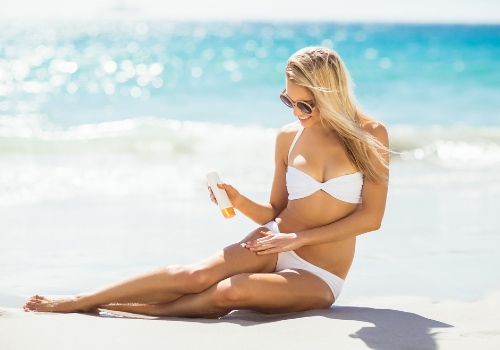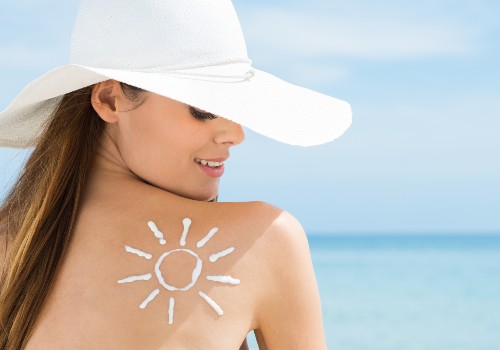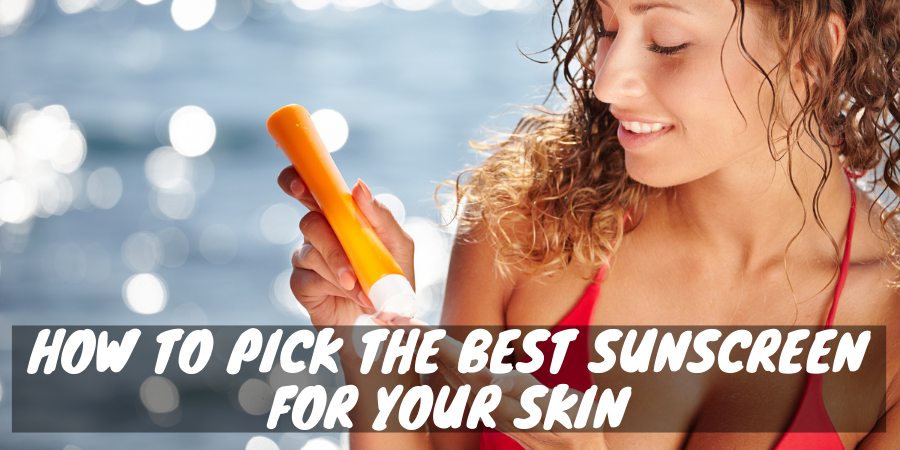What starts as a simple trip down the sunscreen aisle can quickly turn into an overwhelming ordeal. So many choices, so many aspects to consider… how can you possibly make the right decision?
We’ve got your complete guide to sunscreen right here. Read on to learn everything you need to know about protecting your skin from the sun!
What’s on the Label? Deciphering Sunscreen Terminology
It’s important to read your sunscreen labels carefully and understand what all the terms mean. Here’s how to decode all the aspects of your sunscreen label.
What Is SPF?

Every sunscreen is labeled with its sun protection factor, or SPF. Many people think that the SPF indicates the number of minutes that the sunscreen remains effective, but that’s not actually the case.
Rather, the SPF rating reveals the amount of the sun’s rays that can penetrate through the sunscreen to your skin. A sunscreen with an SPF of 30, for example, allows 1/30th (or about 3%) of the sun’s rays through, while an SPF 50 sunscreen allows 1/50th (or about 2%) of the rays through.
Keep in mind that your sunscreen lotion only remains optimally effective for about 2 hours after an application to your skin. Make sure you bring some extra sunscreen if you’re going to be in the sun for longer.
What SPF Should I Use?
The right SPF for you depends on your complexion and your tendency to burn. The lighter your skin, the more likely you are to burn instead of tan, and the higher your SPF rating should be.
For pale skin, SPF 30 should be the absolute minimum you use if you’ll be outside for extended periods. You can go higher for even more protection.
Those with medium or dark skin can get by with an SPF of 15. But it won’t hurt to use a higher SPF if you’re being extra cautious.
These suggestions apply to those who spend a lot of time outside. But if you’ll be exposed to the sun at all, even through a window or for just a few minutes, you should wear sunscreen with an SPF of at least 15 regardless of complexion.
SPF and Vitamin D: Finding a Balance
Vitamin D is an essential nutrient for your bones, muscles and mental health. The most well-known way to get it is by going outside in the sun.
But broad spectrum, high SPF sunscreen blocks UVB rays and thus prevents your body from synthesizing vitamin D from the sun. Does this mean that if you use high SPF sunscreen you’ll become deficient in vitamin D?
While it’s certainly possible that your vitamin D levels could be negatively impacted by wearing sunscreen, most people are able to maintain adequate levels even while wearing sunscreen. That’s because we also get vitamin D from many different foods, including fish, eggs, cheese and fortified orange juice.
Though you don’t need much sun exposure to get enough vitamin D, even a small amount is enough to damage your DNA. You’re much better off wearing broad spectrum, high SPF sunscreen every day and getting your vitamin D through food and supplements.
UVA, UVB, Broad Spectrum: What Does it All Mean?
When we talk about how the sun damages your skin, we’re really talking about two specific types of rays: UVA and UVB. Each of these types of UV light has different effects on your skin — and each requires different ingredients to protect you from them.
UVA rays have longer wavelengths and primarily cause symptoms of aging, like wrinkles and loss of elasticity.
UVB rays have shorter wavelengths and are responsible for causing sunburn.
Both types of UV rays damage the DNA in your skin cells, leading to genetic mutations and, eventually, skin cancer.
That’s why it’s so important to choose a broad spectrum sunscreen. Broad spectrum sunscreen contains ingredients that protect against both UVA and UVB rays, so none of this harmful light ever reaches your skin.
What About Sunscreen Water Resistance?

Even if you’re not planning on going swimming, consider your sunscreen’s water resistance rating.
This value is given in minutes: a water resistance rating of 40 (sometimes called simply “water resistant”) means that the sunscreen will remain effective for 40 minutes of water exposure. The only other water resistance rating is 80 and is sometimes referred to as “very water resistant.”
But water exposure doesn’t necessarily mean full immersion in a pool or ocean. It also applies to rain and sweat — so after 40 minutes of exercise, you’ll need to reapply your sunscreen if it has a water resistance rating of 40.
To be on the safe side, many people use water resistant sunscreen even if they don’t think they’ll sweat or get wet.
Chemical vs. Mineral Sunscreen: Which Is Better?
You’ve decoded most of your sunscreen label, but there’s still one more thing to consider: whether your sunscreen is chemical (also called conventional) or mineral (also called physical).
Chemical sunscreens work by absorbing UV light before your skin can absorb it. You’ll know if your sunscreen is a chemical sunscreen if you see ingredients like oxybenzone, homosalate, octinoxate, avobenzone, octocrylene and octisalate on the label.
Mineral sunscreens don’t contain any of these chemicals. Rather, they contain zinc oxide and titanium dioxide, which repel the sun’s rays rather than absorbing them.
Chemical and Mineral Sunscreen Safety
Both types of sunscreen are highly effective, but some people are concerned about putting chemicals on their skin and potentially absorbing them. We know that at least four of the common chemical sunscreen ingredients are absorbed and do accumulate in the body.
It’s likely that these ingredients are safe if absorbed, given the lack of complications reported by sunscreen users over the years. But there haven’t been any scientific studies on the long-term effects of sunscreen ingredient absorption, so we don’t know for sure.
The two ingredients in mineral sunscreens, on the other hand, are not absorbed by the skin at all. They’re the only sunscreen ingredients that the FDA has labeled “generally regarded as safe and effective.”
This makes mineral sunscreen the preferred option for those who want a safer, more “natural” sunscreen.
There’s a catch, though: mineral sunscreens tend to feel sticky on the skin. They also tend to leave a white cast after being applied, especially on darker skin.
Spray, Stick, Lotion, Gel: What Type of Sunscreen Should I Use?
Now that you know what to look for on a label, it’s time to figure out the best way to apply your sunscreen. There are four common application types: spray, stick, lotion and gel.
Spray Sunscreen: Easy But Uneven
Spray-on sunscreen is popular because it allows you to protect those hard-to-reach areas on your back and shoulders. But it’s less precise and easier to under-apply than other types.
Additionally, it’s not recommended to use spray sunscreen on your face, as you might inhale the sunscreen or the propellant from the can. This can trigger breathing problems, especially if you have asthma or other respiratory conditions.
Stick Sunscreen: Convenient But Tricky
Stick sunscreens are also popular for their portability and ease of use: they won’t explode in a bag and can be easily swiped onto cheeks, hands and other areas. But like sprays, they’re tougher to achieve thick, even coverage with and are best used for quick reapplications.
Lotion and Gel Sunscreen: Comprehensive But Messy
It’s best to use a lotion or gel sunscreen for most applications, as they can be applied thickly and precisely. The average adult needs about a shot glass-sized amount of sunscreen to achieve full body coverage, and that’s easiest with a lotion or gel.
The downside is that these sunscreens can be messy and tricky to apply to certain areas.
Sunscreen and Skin Type: Which Sunscreen Is Best for My Skin?

There’s no one-size-fits-all sunscreen. After all, everyone’s skin is different, so you’ll need to tailor your selection to your specific skin type.
Dry Skin: Try an SPF Moisturizer
For those with dry skin, try looking in the moisturizer section rather than the sunscreen section. Many moisturizers also contain sunscreen ingredients and are labeled with an SPF rating, so they’ll protect you from the sun while keeping your skin hydrated.
You can also try mixing a little of your everyday moisturizer with your sunscreen of choice to get the benefits of both at once.
Oily Skin: Keep it Light
Many sunscreens make your skin look greasy, so if your skin is already oily, use a sunscreen with a lighter feel and consistency. Gel sunscreens tend to go on lighter than lotions, and sunscreen that contains alcohol can help keep grease at bay.
You can also look for ensulizole in the ingredients list, as it’s the least oily UVB-blocking ingredient.
Combination Skin: Err on the Lighter Side
Combination skin can be tough to find products for, but when it comes to sunscreen, the trick is to go light. It’s better to control your oily zones so your sunscreen lasts longer, and you can hydrate your dry areas with a separate moisturizer.
Sensitive Skin: Choose an Unscented Mineral Sunscreen

If your skin is sensitive to products, many sunscreens could be off the table for you. Thankfully, many companies have begun producing sunscreens labeled specifically for sensitive skin.
You can also look for sunscreens that don’t contain fragrances, parabens, preservatives or other irritating ingredients. Mineral sunscreens also tend to be easier on sensitive skin than chemical sunscreens.
Acne-Prone Skin: Go Non-Comedogenic
If you’re prone to acne, you may be hesitant to wear sunscreen out of fear that it’ll make you break out. But there are plenty of options that won’t exacerbate your acne.
Check the label for the phrase “non-comedogenic.” This denotes products that don’t clog pores, thus reducing your risk of breaking out.
Makeup Wearers: Try Tinted SPF or Powder
If you wear makeup, reapplying sunscreen without messing up your look can be tricky. But that’s no reason to skimp on sun protection, and there are many new products that make it easy to keep your makeup fresh and your skin safe.
Many beauty brands now make tinted SPF creams, which you can apply throughout the day to touch up your makeup and your sunscreen at the same time. You can also try SPF powder, which is applied with a brush to minimize the disturbance of your makeup.

